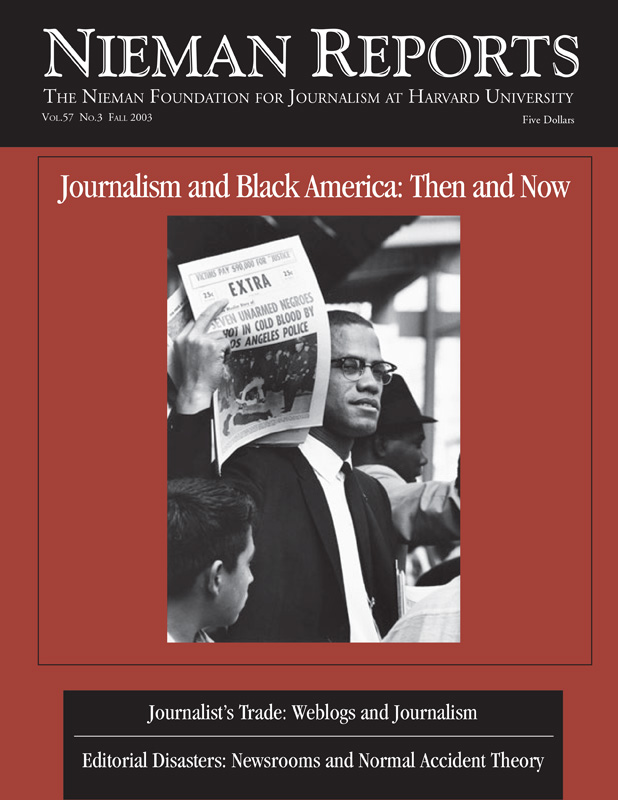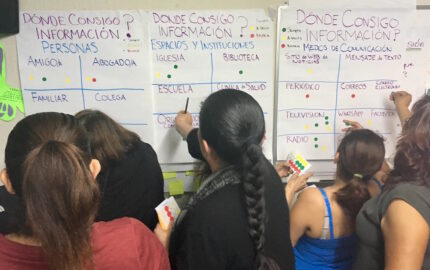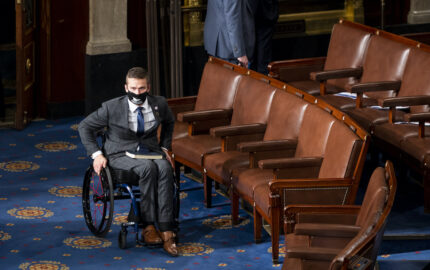
Journalism and Black America: Then and Now
Black and white journalists, at times working as colleagues, at other times separately, have produced the first draft of our nation’s difficult history of race relations. In this issue of Nieman Reports, journalists examine reporting at the intersection of black and white America and look at the racial conditions, climate and conversations in newsrooms. – Melissa Ludtke, Editor
Jay Harris’s argument for minority mainstreaming and diversity in U.S. journalism is the same today as it was 20 years ago, when he was a national correspondent for the Gannett News Service and an African-American city councilman from a small Louisiana city that Harris can’t even remember presented it to him.
“He had been on the city council for years,” the former San Jose Mercury News publisher remembered recently. “But the only time the local paper asked him about anything, it was about a problem in the minority community or about the poor. They never asked him for comment when there was a planning and zoning proposal or a city street paving problem. It’s like he didn’t exist when those questions came up.”
Harris heard those comments in 1984, at a time when he and John Quinn, then the top news executive in the Gannett Company, were beginning work on a policy to end what they considered to be a journalism myopia that was destined to alienate newspapers from their future readers. “Back then, I never understood why reporters and editors always seemed to limit the people they wrote about or talked to,” Harris said. “I don’t think it was intentional in most cases, but rather it was something that no one had really thought about. It was the traditional way of doing things and that had to be changed.”
Twenty Years of Attention to Diversity
Since 1984, Gannett newspapers have been on a path of change to bring a diversity of culture and race into their newsrooms and their pages. Last year, Gannett’s 100 newspapers had nearly 1,000 minority journalists on their staffs amounting to 17.1 percent of the company’s newsroom workforce. That figure exceeded by nearly five percentage points the average percentage of minority journalists working at daily newspapers nationwide in 2002.
Gannett newspapers have also been evaluated annually during the last 20 years on how well they met the expectation that each newspaper include expert minority voices where appropriate and reflect the activities of each part of their communities. “Mainstreaming and diversity in our newsrooms and our news pages are essential to our newspapers maintaining credibility with our communities,” said George Benge, the executive who oversees the company-wide program, named in typical Gannett fashion as the “All-American Review: Mainstreaming and Diversity.” “We believe that the program will provide our newspapers with the credibility needed to remain strong over the long term in the communities we serve.”
Executives at Gannett define “mainstreaming” as the appropriate use of minority experts in the reporting of stories. For example, when a sportswriter is working a story about how intercollegiate athletics are financed, then the reporter should include a minority expert on the topic. Gannett defines “diversity” as relating to stories about minorities and their communities. That means that to diversify the story on intercollegiate athletic finance, the reporter would use a predominantly black college or a conference like the Southwestern Conference to illustrate the impact of increased spending on athletic programs.
But the company’s mainstreaming and diversity program are not without controversy. Given the Jayson Blair scandal at The New York Times, these reporting policies must be understood within the context of the company’s intentions and the execution of those intentions. Simply put, does the goal of having minorities well represented inside the newsroom and in news columns amount to cynical political correctness, or do these policies uphold journalism’s primary responsibility to mirror accurately individual and community accomplishment and failure?
Gannett’s Policies at Work
Shannon Owens recently became a sportswriter for The Des Moines Register. Owens, the great niece of Olympian sprinter Jesse Owens and the sister of Chris Owens, a forward for the NBA Memphis Grizzlies, is enthusiastic, knowledgeable, but relatively inexperienced in sports writing at age 23. She wrote for the student newspaper at the University of Texas, where she majored in journalism, and landed an internship at the Columbus (Ga.) Ledger-Enquirer in 2002 through the prestigious sports journalism institute sponsored by the National Association of Black Journalists and The Associated Press Sports Editors organization. She is only the second minority journalist hired to write full-time for The Des Moines Register sports section in 30 years. Despite this, she is one of 18 fulltime minority reporters and editors within the 160-member Register newsroom that amounts to 11 percent of the newsroom and just 1.1 percentage point below the minority population in the Des Moines metropolitan statistical area.
Owens’s first Register assignment was to help cover a 13-state regional soccer tournament held in Des Moines in June. Owens had never covered a soccer game before and felt completely out of her comfort zone. Like any rookie serious about learning her job, she spent hours watching soccer on morning and afternoons so hot that she complained of sunburn. “I didn’t know I could [get sunburned],” she said with a laugh.
But Owens is dead serious about achieving her goal as a journalist. She wants to become a sports projects reporter and is already chomping to get a project underway. “I am curious about why minorities seem to concentrate themselves into one or two sports. Why they choose basketball and not soccer or something else,” she said. Her idea is similar to a recent Green Bay Press-Gazette story that can be found on a Gannett editors’ Web site that lists hundreds of stories reflecting diversity in communities served by Gannett newspapers. In Green Bay, the Gannett-owned newspaper wondered why so few minorities participated in athletics at Green Bay’s five area high schools.
The paper’s reporting explained why. Among the less obvious reasons was that many potential athletes—many of whom are recent Hispanic and Hmong immigrants—still have trouble with English and get confused when taking direction from coaches. Also, many of their parents—particularly those with daughters—oppose athletic participation because of their cultural beliefs. “This story area has some potential,” Owens said. “I just hope I can work it in with everything else I have to do.”
Owens’s addition to the Register staff is just one example of what Gannett contends is the benefit of the company’s mainstreaming and diversity program. Qualified minority candidates are difficult to find, particularly minority female sportswriters, but they can be found and trained. The primary benefit—when they become staff members—is the different perspective they bring to the newsroom in determining what is and isn’t news. Questions about minority participation in Des Moines high school sports aren’t something that occurs to many sportswriters who aren’t from a minority background. For readers, there are benefits, too. Different parts of a community will identify with a newspaper when they believe the local newspaper understands their views and concerns.
Benge, who is a member of the Cherokee Nation of Oklahoma and was editor at two Gannett newspapers before becoming a corporate executive, points to recent U.S. population projections to emphasize the business rationale behind Gannett’s policies. “Over the next 50 years, the percentage of minorities in the United States is expected to grow from 26 to 47 percent of the total population,” said Benge. “That means millions of potential readers will be alive to witness and experience a monumental cultural transformation. We have to be ready for that.”
Benge isn’t strident about the company policy but also isn’t afraid to confront tough issues. His message to Gannett staffers is a positive one, based on the belief that good journalism is about the successes and failures of all parts of a community—not just the dominant one. “There are a lot of good stories out there, but we need to find them. Sometimes that’s easy and sometimes that’s hard,” he said.
Measuring Success
Gannett publications use two procedures to assure that mainstreaming and diversity become a part of the newsroom culture. Each newspaper must establish a list of minority experts for use by its reporters. These lists, often divided on the basis of subject, are to be used by reporters and editors to expand the pool of sources. Benge acknowledges that these lists produce varying levels of success. In some newsrooms, reporters turn to them constantly; in other newsrooms, they are largely ignored.
Benge also recognizes the limits to which such lists can be developed and used. For example, there are plenty of minority experts in areas such as sports, where minority athletes are predominant, but in the front offices, many fewer can be found. Currently, major professional sports have only two minority owners—Robert Johnson, who owns the NBA team in Charlotte, North Carolina and Arturo Moreno, who recently became Major League Baseball’s first Hispanic owner with the purchase of the Anaheim Angels. Still, these lists can be effective tools to help reporters and editors avoid relying on the same people who tend to be quoted again and again.
But sometimes by identifying “new” sources, they can quickly become overused sources. In 1999, Brill’s Content found The Greenville (S.C.) News, a Gannett newspaper, quoted the same Asian woman three times in 13 weeks in stories about a new area jogging path, the need to change area rugs to match the season, and an Elton John concert to be held in the community. “We don’t want the same person quoted in every story because that serves no real purpose and acts to cheapen our effort,” Benge said. “The source list, if updated and used properly, can provide excellent sources for comment and is good, ethical journalism.”
A newspaper self-audit is done annually by a newsroom committee as part of the All-American competition. These audits—like the rest of the company-wide competition—can be effective tools in illuminating problems with stereotypes, as well as spotting missed opportunities to be more inclusive. “If a story is being written on the changing family, why not include an interview and picture of a minority family?” Benge said. “Subjects for features, businesses, sports as well as the daily news report can cut across all parts of a community, and we have to show our readers that we recognize that.”
When Benge met with newsroom editors from several Ohio and Wisconsin newspapers that Gannett had acquired, one of his tasks was to inform the news executives of the core corporate value to expand minority inclusion into their newsrooms and onto their daily pages. “Actually the meeting was going pretty well until I began going through some examples of what I considered to be inappropriate,” he said.
Benge pulled out a high school football preview section from an Ohio paper. The cover headline, “Redskins on Warpath,” led to a discussion about the use of mascots in Gannett newspapers. Gannett doesn’t have a corporate policy on the mascot issue, so decisions are left to local editors. But in this case, the headline provided an avenue for a discussion about these broader corporate issues. “Our discussion got pretty frank and that was a good thing,” Benge said. “I think I was able to point out pretty well just why that shouldn’t have been the headline.”
Gannett provides newspapers with direction based on the values it wants its newspapers to uphold. But Gannett also monitors how well each of its newspapers is adhering to its principles of mainstreaming and diversity and provides tools to help editors and reporters do this. “We believe in local autonomy on issues like that [the use of mascots],” Benge said. “Our company policy about mainstreaming and diversity is about how we want our company to operate. Local papers still have the ability to make decisions based on how they want to report the news.”
Tom Witosky, a 1992 Nieman Fellow, is sports projects writer for The Des Moines Register and also a member of the Cherokee Nation of Oklahoma.
“He had been on the city council for years,” the former San Jose Mercury News publisher remembered recently. “But the only time the local paper asked him about anything, it was about a problem in the minority community or about the poor. They never asked him for comment when there was a planning and zoning proposal or a city street paving problem. It’s like he didn’t exist when those questions came up.”
Harris heard those comments in 1984, at a time when he and John Quinn, then the top news executive in the Gannett Company, were beginning work on a policy to end what they considered to be a journalism myopia that was destined to alienate newspapers from their future readers. “Back then, I never understood why reporters and editors always seemed to limit the people they wrote about or talked to,” Harris said. “I don’t think it was intentional in most cases, but rather it was something that no one had really thought about. It was the traditional way of doing things and that had to be changed.”
Twenty Years of Attention to Diversity
Since 1984, Gannett newspapers have been on a path of change to bring a diversity of culture and race into their newsrooms and their pages. Last year, Gannett’s 100 newspapers had nearly 1,000 minority journalists on their staffs amounting to 17.1 percent of the company’s newsroom workforce. That figure exceeded by nearly five percentage points the average percentage of minority journalists working at daily newspapers nationwide in 2002.
Gannett newspapers have also been evaluated annually during the last 20 years on how well they met the expectation that each newspaper include expert minority voices where appropriate and reflect the activities of each part of their communities. “Mainstreaming and diversity in our newsrooms and our news pages are essential to our newspapers maintaining credibility with our communities,” said George Benge, the executive who oversees the company-wide program, named in typical Gannett fashion as the “All-American Review: Mainstreaming and Diversity.” “We believe that the program will provide our newspapers with the credibility needed to remain strong over the long term in the communities we serve.”
Executives at Gannett define “mainstreaming” as the appropriate use of minority experts in the reporting of stories. For example, when a sportswriter is working a story about how intercollegiate athletics are financed, then the reporter should include a minority expert on the topic. Gannett defines “diversity” as relating to stories about minorities and their communities. That means that to diversify the story on intercollegiate athletic finance, the reporter would use a predominantly black college or a conference like the Southwestern Conference to illustrate the impact of increased spending on athletic programs.
But the company’s mainstreaming and diversity program are not without controversy. Given the Jayson Blair scandal at The New York Times, these reporting policies must be understood within the context of the company’s intentions and the execution of those intentions. Simply put, does the goal of having minorities well represented inside the newsroom and in news columns amount to cynical political correctness, or do these policies uphold journalism’s primary responsibility to mirror accurately individual and community accomplishment and failure?
Gannett’s Policies at Work
Shannon Owens recently became a sportswriter for The Des Moines Register. Owens, the great niece of Olympian sprinter Jesse Owens and the sister of Chris Owens, a forward for the NBA Memphis Grizzlies, is enthusiastic, knowledgeable, but relatively inexperienced in sports writing at age 23. She wrote for the student newspaper at the University of Texas, where she majored in journalism, and landed an internship at the Columbus (Ga.) Ledger-Enquirer in 2002 through the prestigious sports journalism institute sponsored by the National Association of Black Journalists and The Associated Press Sports Editors organization. She is only the second minority journalist hired to write full-time for The Des Moines Register sports section in 30 years. Despite this, she is one of 18 fulltime minority reporters and editors within the 160-member Register newsroom that amounts to 11 percent of the newsroom and just 1.1 percentage point below the minority population in the Des Moines metropolitan statistical area.
Owens’s first Register assignment was to help cover a 13-state regional soccer tournament held in Des Moines in June. Owens had never covered a soccer game before and felt completely out of her comfort zone. Like any rookie serious about learning her job, she spent hours watching soccer on morning and afternoons so hot that she complained of sunburn. “I didn’t know I could [get sunburned],” she said with a laugh.
But Owens is dead serious about achieving her goal as a journalist. She wants to become a sports projects reporter and is already chomping to get a project underway. “I am curious about why minorities seem to concentrate themselves into one or two sports. Why they choose basketball and not soccer or something else,” she said. Her idea is similar to a recent Green Bay Press-Gazette story that can be found on a Gannett editors’ Web site that lists hundreds of stories reflecting diversity in communities served by Gannett newspapers. In Green Bay, the Gannett-owned newspaper wondered why so few minorities participated in athletics at Green Bay’s five area high schools.
The paper’s reporting explained why. Among the less obvious reasons was that many potential athletes—many of whom are recent Hispanic and Hmong immigrants—still have trouble with English and get confused when taking direction from coaches. Also, many of their parents—particularly those with daughters—oppose athletic participation because of their cultural beliefs. “This story area has some potential,” Owens said. “I just hope I can work it in with everything else I have to do.”
Owens’s addition to the Register staff is just one example of what Gannett contends is the benefit of the company’s mainstreaming and diversity program. Qualified minority candidates are difficult to find, particularly minority female sportswriters, but they can be found and trained. The primary benefit—when they become staff members—is the different perspective they bring to the newsroom in determining what is and isn’t news. Questions about minority participation in Des Moines high school sports aren’t something that occurs to many sportswriters who aren’t from a minority background. For readers, there are benefits, too. Different parts of a community will identify with a newspaper when they believe the local newspaper understands their views and concerns.
Benge, who is a member of the Cherokee Nation of Oklahoma and was editor at two Gannett newspapers before becoming a corporate executive, points to recent U.S. population projections to emphasize the business rationale behind Gannett’s policies. “Over the next 50 years, the percentage of minorities in the United States is expected to grow from 26 to 47 percent of the total population,” said Benge. “That means millions of potential readers will be alive to witness and experience a monumental cultural transformation. We have to be ready for that.”
Benge isn’t strident about the company policy but also isn’t afraid to confront tough issues. His message to Gannett staffers is a positive one, based on the belief that good journalism is about the successes and failures of all parts of a community—not just the dominant one. “There are a lot of good stories out there, but we need to find them. Sometimes that’s easy and sometimes that’s hard,” he said.
Measuring Success
Gannett publications use two procedures to assure that mainstreaming and diversity become a part of the newsroom culture. Each newspaper must establish a list of minority experts for use by its reporters. These lists, often divided on the basis of subject, are to be used by reporters and editors to expand the pool of sources. Benge acknowledges that these lists produce varying levels of success. In some newsrooms, reporters turn to them constantly; in other newsrooms, they are largely ignored.
Benge also recognizes the limits to which such lists can be developed and used. For example, there are plenty of minority experts in areas such as sports, where minority athletes are predominant, but in the front offices, many fewer can be found. Currently, major professional sports have only two minority owners—Robert Johnson, who owns the NBA team in Charlotte, North Carolina and Arturo Moreno, who recently became Major League Baseball’s first Hispanic owner with the purchase of the Anaheim Angels. Still, these lists can be effective tools to help reporters and editors avoid relying on the same people who tend to be quoted again and again.
But sometimes by identifying “new” sources, they can quickly become overused sources. In 1999, Brill’s Content found The Greenville (S.C.) News, a Gannett newspaper, quoted the same Asian woman three times in 13 weeks in stories about a new area jogging path, the need to change area rugs to match the season, and an Elton John concert to be held in the community. “We don’t want the same person quoted in every story because that serves no real purpose and acts to cheapen our effort,” Benge said. “The source list, if updated and used properly, can provide excellent sources for comment and is good, ethical journalism.”
A newspaper self-audit is done annually by a newsroom committee as part of the All-American competition. These audits—like the rest of the company-wide competition—can be effective tools in illuminating problems with stereotypes, as well as spotting missed opportunities to be more inclusive. “If a story is being written on the changing family, why not include an interview and picture of a minority family?” Benge said. “Subjects for features, businesses, sports as well as the daily news report can cut across all parts of a community, and we have to show our readers that we recognize that.”
When Benge met with newsroom editors from several Ohio and Wisconsin newspapers that Gannett had acquired, one of his tasks was to inform the news executives of the core corporate value to expand minority inclusion into their newsrooms and onto their daily pages. “Actually the meeting was going pretty well until I began going through some examples of what I considered to be inappropriate,” he said.
Benge pulled out a high school football preview section from an Ohio paper. The cover headline, “Redskins on Warpath,” led to a discussion about the use of mascots in Gannett newspapers. Gannett doesn’t have a corporate policy on the mascot issue, so decisions are left to local editors. But in this case, the headline provided an avenue for a discussion about these broader corporate issues. “Our discussion got pretty frank and that was a good thing,” Benge said. “I think I was able to point out pretty well just why that shouldn’t have been the headline.”
Gannett provides newspapers with direction based on the values it wants its newspapers to uphold. But Gannett also monitors how well each of its newspapers is adhering to its principles of mainstreaming and diversity and provides tools to help editors and reporters do this. “We believe in local autonomy on issues like that [the use of mascots],” Benge said. “Our company policy about mainstreaming and diversity is about how we want our company to operate. Local papers still have the ability to make decisions based on how they want to report the news.”
Tom Witosky, a 1992 Nieman Fellow, is sports projects writer for The Des Moines Register and also a member of the Cherokee Nation of Oklahoma.


